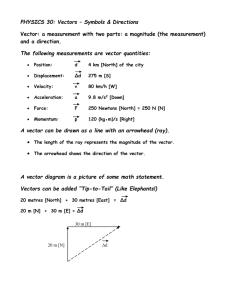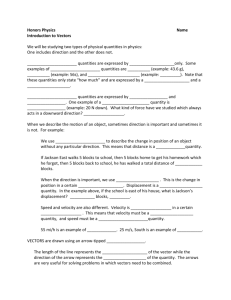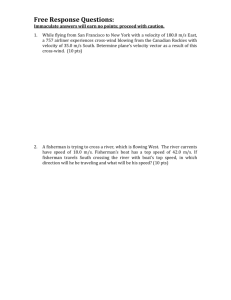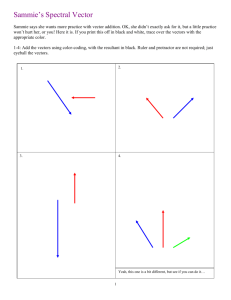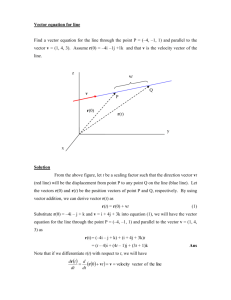Vectors
advertisement
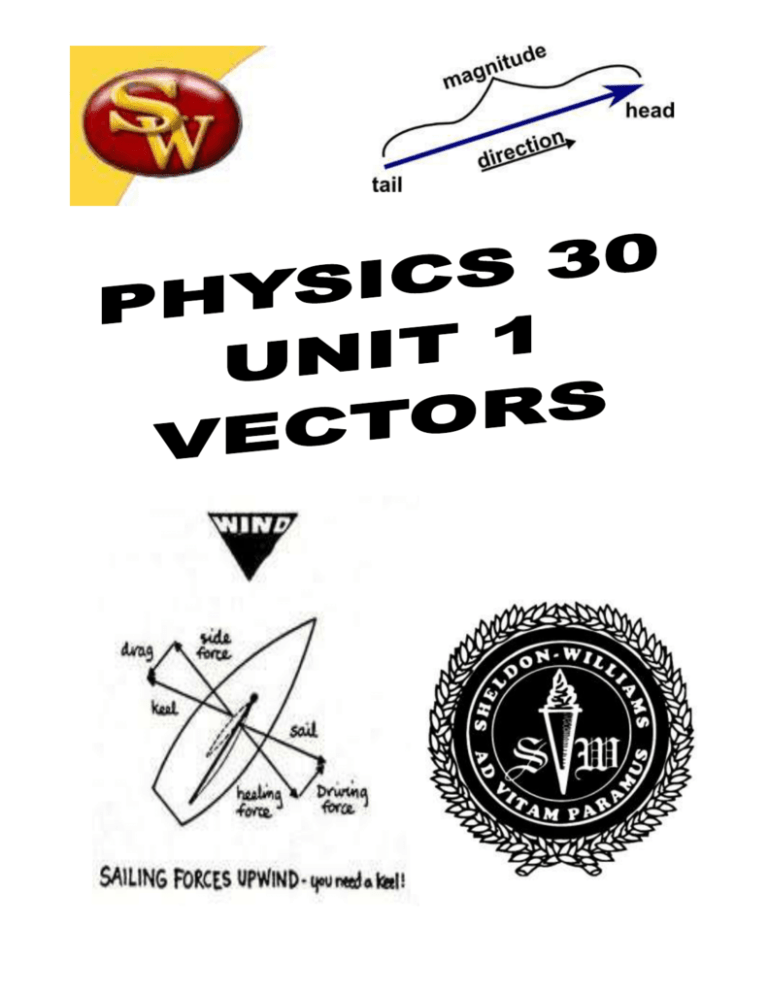
Key Terms & Concepts: vector scaler magnitude direction heading bearing components math statement Pythagoras Trig ratios (SOHCAHTOA) Law of Sines Law of Cosines Outcomes: Students should be able to 1. represent displacement, velocity, acceleration, force, momentum as a vector 2. represent information in a math statement 3. combine vectors in a vector diagram 4. solve vector diagrams Equations: Heading + Bearing = Result 1 PHYSICS 30: Vectors – Symbols & Directions Vector: a measurement with two parts: a magnitude (the measurement) and a direction. The following measurements are examples of vector quantities: Position: d 4 km [North] of the city Displacement: Δd 275 m [S] displacement = distance + direction Velocity: v 80 km/h [W] velocity = speed + direction Acceleration: a 9.8 m/s2 [Down] Force: F 250 Newtons [North] = 250 N [N] Momentum: p 120 (kg●m)/s [Right] A vector can be drawn as a line with an arrowhead (ray). The length of the ray represents the magnitude of the vector. The arrowhead shows the direction of the vector. A vector diagram is a picture of some math statement. 20 metres [North] + 30 metres [East] = Δd 20 m [N] + 30 m [E] = Δd Math Statements 30 m [E] 20 m [N] Δd Vector Diagram Vectors can be added “Tip-to-Tail” (Like Elephants!) 2 PHYSICS 30: Vectors – From Here to There Activity “From there to here, from here to there, funny things are everywhere.” (One Fish Two Fish Red Fish Blue Fish, Dr. Suess) 1. List the segments in order which make up your path from the doorway of our classroom to: . 3[W]+ 2. What is the total number of steps taken to reach ? 3. Combine all segments which were traveled in the same direction. Write a math statement which represents the combining of steps in the same direction. ( example: 12 steps [west] + 4 steps [south] + 37 steps [east] + 10 steps [north]) Use the variable d to represent the displacement (change in position) you have traveled. d = 4. Combine opposite directions and rewrite your statement from #3. We can do this because traveling west is just really traveling backwards east, and vice versa. (12 steps west = -12 steps east) d = 5. Can we simplify the math statement in #4 any further? Why or why not? 6. Think about how to show the “addition” or combining of two different terms. This vector represents 10 metres [East] This vector represents 5 metres [North} 3 What would 10 m [E] + 5 m [N] look like? 7. Draw a picture for the math statement you created in #4. 8. Create a triangle from your diagram in #7 and solve the triangle so that you know the length of each side and the value of each angle. 9. How far is it directly from our doorway to What is the direction directly from our doorway to ? ? 10. How does your answer for #2 differ from your answer for #8? Why does this difference exist? 4 PHYSICS 30: Vectors – Bike Courier Assignment A bicycle courier makes deliveries in the downtown area of a city. The bike courier rides the following route in order to complete all his deliveries: 16 blocks south 4 blocks north 8 blocks west 7 blocks west 5 blocks north 5 blocks north 11 blocks east 8 blocks east 1. Draw a diagram representing the path the bike courier traveled. Give information about the scale you use to represent a block and the orientation of directions on the page. 2. Write a math statement which represents the path the bike courier traveled. Use the symbols [N], [S], [E], and [W] to represent directions. ∆d = 16 blocks [S] + ….. 3. Simplify the math statement by combining terms with similar directions. 4. Simplify the math statement further by combining terms with opposite directions. Example: 4 blocks [W] = -4 blocks [E] 5. You should have a math statement with two terms. Why can’t you combine these two terms by combining the numbers to give you only one term? 6. The simplified math statement represents the displacement of the bike courier. Draw a diagram that represents this simplified math statement. Use a line with an arrowhead (ray) to represent each term. Each ray in the diagram is a vector. A vector is a measurement with a direction. Be sure to label each vector. 7. The displacement is the third side of the triangle from where the bike courier started to where the bike courier ended up. Use the Pythagorean Theorem to calculate the length of the third side of the triangle. Use trig ratios to calculate the angle which describes the direction of the displacement. How could you describe to another the person the direction of the bike couriers’ overall displacement? 5 Use Pythagoras and SOHCAHTOA to help solve right-angle triangles. Pythagoras 𝒂𝟐 + 𝒃𝟐 = 𝒄𝟐 B SOHCAHTOA 𝒔𝒊𝒏 𝜽 = 𝒐𝒑𝒑 𝒉𝒚𝒑 𝒄𝒐𝒔 𝜽 = 𝒂𝒅𝒋 𝒉𝒚𝒑 hypotenuse c A 𝒐𝒑𝒑 𝒕𝒂𝒏 𝜽 = 𝒂𝒅𝒋 θ opposite a 90º b adjacent C Use the Law of Sines and the Law of Cosines to solve triangles that don’t have a right angle. C b A a c Law of Sines: Sin A = Sin B = Sin C a b c B Law of Cosines: a2 = b2 + c2 – 2bc CosA or b2 = a2 + c2 – 2ac CosB or c2 = a2 + b2 – 2ab CosC COMPONENTS of a VECTOR: two vectors that can be used to represent or replace a single vector. Components are used to simplify the direction of a vector. ⃗⃗⃗⃗ 𝑉𝐸 ⃗ 𝑉 ⃗⃗⃗ 𝑉𝑆 ⃗ = ⃗⃗⃗⃗ 𝑉 𝑉𝐸 + ⃗⃗⃗ 𝑉𝑆 6 Direction: the direction of a vector can be expressed using north, east, west, or south as a reference direction. N W 20º E [E 20º S] 70º [S 70º E] S or Bearing = 110º (measured clockwise from North) Heading & Bearing: Objects like planes and boats can be affected by outside forces such as wind and waves. There can be a difference in the direction an object is pointed and the S direction it actually travels. BEARING: the direction the plane actually travels WINDY HEADING: the direction the plane is pointed/aimed/headed Object + Effect = Result Heading + Effect = Bearing Examples: plane + wind = result or boat + current = result 7 PHYSICS 30: Vectors – Practice 1. Use the three vectors to draw and calculate each math statement. ⃗𝑨 ⃗ = 10 m [Right] ⃗𝑩 ⃗ = 6 m [Up] ⃗𝑪 = 4 m [Left] ⃗ + ⃗𝑩 ⃗ = ⃗⃗⃗⃗⃗ a. ⃗𝑨 ∆𝒅 𝟏𝟎𝒎[𝑹] + 𝟔𝒎[𝑼𝒑] = ⃗⃗⃗⃗⃗ ∆𝒅 ⃗ = ⃗⃗⃗⃗⃗ ⃗⃗ + 𝑪 b. 𝑩 ∆𝒅 ⃗ + ⃗𝑪 = ⃗⃗⃗⃗⃗ c. ⃗𝑨 ∆𝒅 ⃗ + ⃗𝑨 = ⃗⃗⃗⃗⃗ d. ⃗𝑩 ∆𝒅 8 2. Draw in and calculate the north, south, east, or west components of each vector. a. Displacement 400 km [S 40º E] → 𝐝𝐒 → 𝐝𝐄 b. Velocity 50 m/s [R 60° Up] c. Acceleration d. Force 6.8 m/s2 [L 15° Dn] 1200 Newtons [W 40° N] = 1200 N [W 40º N] 9 PHYSICS 30: Vectors – Components of Vectors – Problem Practice 1. A glider flies 15 km [W]. The pilot turns the glider to fly for 12 km in the direction [N 40º W]. a. Write a math statement for the displacement of the glider. b. Draw a vector diagram for this math statement. Don’t solve the triangle. c. Find the components of the 12 km [N 40º W] vector. d. Rewrite and simplify the math statement for the glider’s displacement. e. Draw a vector diagram for the glider’s displacement. f. Solve the vector diagram to determine the magnitude and direction of the glider’s displacement. 2. A sailboat sails for 5 km in the direction [S 70º E]. The sailboat then turns and sails for 8 km in the direction [W 30º S]. a. Write a math statement for the displacement of the sailboat. b. Draw a vector diagram for the sailboat’s displacement. Don’t solve the triangle. c. Find the components for the two vectors. d. Rewrite and simplify the math statement for the sailboat’s displacement. e. Draw a vector diagram for the sailboat’s displacement. f. Solve the vector diagram to determine how far and in what direction the sailboat is from where it started. 10 Write a math statement for each situation. Calculate the solution for each situation. River Current: 2 m/s [S] River Current: 2 m/s [S] Swimmer can swim at a speed of 1 m/s relative to the water River Current: 2 m/s [S] Swimmer can swim at a speed of 1 m/s relative to the water River Current: 2 m/s [S] Kayaker can paddle at a speed of 5 m/s relative to the water and keeps kayak pointed East River Current: 2 m/s [S] Swimmer can swim at a speed of 1 m/s relative to the water River Current: 2 m/s [S] Kayaker can paddle at a speed of 5 m/s relative to the water and wants to travel directly across river 11 PHYSICS 30: Vectors – Heading & Bearing Practice Questions 1. A river has a current that flows from west to east. You want to travel directly across the river from the south bank to the north. Because of your knowledge of physics you decide to head your boat in which direction? Explain your choice. 2. The same river flows towards the east. Because of your knowledge of physics you head your boat in the direction of [N 53° W]. You end up traveling with a resulting velocity of 6.0 m/s [N]. a. b. c. d. Write a math statement using as a template: Boat + Current = Result Draw a vector diagram for your math statement. What is the velocity of the current? What is the boat speed relative to the water? (This is the speed the boat would be capable of in still water.) 3. A boat is capable of traveling at a speed of 12 m/s relative to the water (the speed of the boat without a current). The driver of the boat wishes to cross directly from the south shore to the north shore at a point where the river is 800 metres wide. The current is flowing [East] at a rate of 2.5 m/s and the water temperature is 15°C. a. Write a math statement representing the combining of the boat and current to produce a resulting trip directly across the river. Boat + Current = Result b. Draw a vector diagram for your math statement. c. Calculate the heading the driver of the boat must steer. d. Calculate the resulting velocity of the boat. e. Calculate how long it will take the boat to cross the river. 4. A pilot takes off in his plane from Regina to travel to Winnipeg which is 600 km [E] of Regina. There is considerable cloud cover so the pilot cannot see the ground. He maintains a speed and heading of 150 km/h [East] using his air speed indicator and compass. The pilot is unaware of a wind blowing the plane south at a rate of 45 km/h (he doesn’t know the air is moving). a. b. c. d. e. f. Write a math statement representing the plane’s heading combined with the wind. Draw a vector diagram for the math statement. Does the plane fly towards Winnipeg? What direction does it end up traveling? What direction should the pilot head the plane if he wants to fly directly to Winnipeg? What will be the resulting velocity of the plane if the pilot steers the correct heading so the plane flies directly to Winnipeg? How long will it take the plane to travel from Regina to Winnipeg? 5. A small plane is headed south with a relative velocity of 160 km/h to the air (this is its air speed). After two hours the pilot spots a landmark and checking with a map determines that the plane has traveled a distance of 420 km from its starting point. Also from the map the pilot determines that the plane has traveled in a southeasterly direction. Calculate the wind speed if the direction of the wind is [East]. 12 PHYSICS 30: Vectors – Homework Assignment 1. A plane flies 676 km [North]. The plane then turns and flies 112 km [East]. a. Write a math statement for the planes displacement after the two legs of its trip. b. Draw a vector diagram for this situation. c. Calculate the resulting displacement (magnitude and direction) of the plane? 2. Two tow trucks are used to pull a stranded car from a snowy field. Able Towing supplies a force of 2500 Newtons towards the north. Dun-Rite Towing supplies a force of 2500 Newtons towards the west. a. Sketch an overhead view showing the real world situation. b. Write a math statement for the situation. c. Draw a vector diagram showing the combination of these two towing forces. d. Calculate the magnitude and direction of the resulting force? 3. Firefighters use powerful streams of water from their fire hoses to move a large ball across a grass field. The team from Fire Hall #4 supplies a constant force of 1400 Newtons towards the south. The team form Fire Hall #7 maintains a constant force of 1000 Newtons towards the east. a. Sketch a diagram showing this situation. b. Write a math statement for this situation. c. Draw a vector diagram showing the combination of these two forces. d. Calculate the magnitude and direction of the resulting force acting on the ball. 4. A motor boat is crossing a 628 metre wide river which has a current of 10.0 m/s south. The boat is capable of a speed of 25.0 m/s. a. Draw a diagram for this situation. b. If the driver heads the boat downstream: i. Write a math statement for the boat’s resulting velocity. ii. Calculate the boat’s resulting velocity. c. If the driver drives the boat so that it maintains a heading of east: i. Write a math statement for the boat’s resulting velocity. ii. Draw a vector diagram of this math statement. iii. Calculate the resulting velocity of the boat. iv. How much time will it take the boat to reach the far side of the river? d. In what direction must the driver head the boat in order to travel straight across the river? 13 5. A plane is flying with a velocity of 216 km/h [S 30°W]. What are the south and west components of the velocity? 6. A sailboat travels 14.8 km in the direction [N 35° E]. The sailboat then tacks (nautical talk for turns) and travels 11.4 km [W 70° S]. What is the resulting magnitude and direction of the sailboat’s displacement? 7. A helicopter is going to fly from Regina to Dauphin, Manitoba. Dauphin is 275 km from Regina is a direction of [N 45 ° E]. The helicopter is capable of a speed of 120 km/h under its own power. There is a wind blowing from the west to the east at a velocity of 54km/h. a. Write a math statement for the helicopter’s resulting velocity. b. Draw the vector diagram for the helicopter’s resulting velocity. c. Calculate the heading the helicopter pilot needs to take. d. Calculate the length of time it will take to fly directly from Regina to Dauphin. Answers: 1. 685 km [N 9° E] or [E 81°N] 2. 3536 N [N 45° W] or [W 45° N] 3. 1720 N [S 36° E] or [E 54° S] 4. b) 35 m/s [S] c) 26.9 m/s [E 22° S] or [S 68° E] 5. 187 km/h [S] & 108 km/h [W] 6. 4.8 km [N 73° E] or [E 17° N] 7. 153 km/h 1.80 hrs time=25.1 sec d) head:[E 24° N] or [N 66° E] 14 PHYSICS 30: Vectors - Review 1. A plane flies 120 km east. The plane then turns and flies 210 km north. a) Write a math statement which represents the path of the plane. b) Draw a vector diagram which illustrates the path flown by the plane. c) Calculate the plane’s displacement (magnitude and direction) after the two parts of its flight. This is not how far the plane has traveled, but how far it is from where it started. d) What direction would the play need to fly in order to return from where it started? 2. A sailboat experiences two forces which result in pushing the sailboat forward. The wind produces a push through the sails of the sailboat with a force of 1400 Newtons [east]. The water pushes on the keel and bottom of the sailboat with a resisting force of 1000 Newtons [N 30 W]. Together these two forces produce a resulting force that pushes the sailboat forward. a) Write a math statement which represents the forces acting on the sailboat. b) Draw a vector diagram which illustrates the math statement, the forces acting on the sailboat. c) Calculate the resulting force acting on the sailboat. Be sure to calculate both the magnitude and direction of the resulting force. 3. A hiker walks 3 km north. She then turns and walks 3 km [E 40 S]. Finally she turns and walks a distance of 7 km south. a) What distance does the hiker walk? b) Write a math statement that represents the path the hiker travels. c) Draw a vector diagram of the simplified math statement that represents the hiker’s displacement. d) How far is the hiker from where she started? e) In what direction does the hiker need to walk in order to return directly to where she started? 4. A golfer hits his golf ball 240 metres [W 35 S]. Then the golfer hits his golf ball 80 metres [N 50 W]. a) Explain how you would determine the length and direction of the displacement of the golf ball from its starting position after the two shots. b) When we draw a vector diagram, what are we trying to represent? c) Why is it necessary to draw vector diagrams? 15 5. A Canada Goose is migrating from Saskatchewan to somewhere warmer. The goose is capable of flying at a speed of 70 km/h. There is a steady wind blowing form west to east at a speed of 40 km/h. a) If the goose maintains a heading of south, what is the resulting velocity of the goose? b) If the goose maintains a heading of south, how far south will it be in three hours? c) In what direction must the goose head in order to fly with a bearing of south? d) If the goose maintains a bearing of south, how far south will it be in three hours? e) What is the difference between speed and velocity? f) What is the difference between distance traveled and displacement? 1. Plane: ⃗⃗⃗⃗⃗⃗ a. 120 𝑘𝑚 [𝐸] + 210 𝑘𝑚[𝑁] = Δ𝑑 b. c. ⃗⃗⃗⃗⃗⃗ Δ𝑑 = 242 𝑘𝑚 [𝐸 60° 𝑁]𝑜𝑟 [𝑁 30°𝐸] d. [W 60° S] or [S 30° W] 2. Sailboat: a. 𝐹 = 1400 𝑁 [𝐸] + 1000 𝑁 [𝑁 30° 𝑊] b. 𝐹 = 1400 𝑁 [𝐸] + 866 𝑁 [𝑁] + 500 𝑁 [𝑊] c. 𝐹 = 1249 𝑁 [𝐸 44° 𝑁]𝑜𝑟 [𝑁 46° 𝐸] 3. Hiker: a. d = 13 km ⃗⃗⃗⃗⃗ = 4 𝑘𝑚 [𝑆] + 3 𝑘𝑚 [𝐸 40°𝑆] b. ∆𝑑 c. ⃗⃗⃗⃗⃗ ∆𝑑 = 4 𝑘𝑚 [𝑆] + 2.3 𝑘𝑚 [𝐸] + 1.9 𝑘𝑚 [𝑆] d. ⃗⃗⃗⃗⃗ ∆𝑑 = 6.3 𝑘𝑚 [𝑆 21° 𝐸]𝑜𝑟 [𝐸 69° 𝑆] e. [N 21° W] or [W 69° S] 4. Golfing: a. Procedure: i. find the components of each vector ii. combine similar directions iii. write a simplified math statement iv. draw the vector diagram of the math statement v. solve the triangle using SOHCAHTOA and Pythagoras b. vector diagram: a picture of a math statement c. vector diagrams allow us to combine tow vectors with different directions 5. Canada Goose: 𝑘𝑚 [𝑆 30° 𝐸]𝑜𝑟 [𝐸 60°𝑆] a. ⃗⃗⃗⃗ 𝑣𝑅 = 81 ℎ ⃗⃗⃗⃗ b. 𝑑𝑆 = 210 𝑘𝑚 [𝑆] c. d. e. f. [S 35° W] or [W 55° S] ⃗⃗⃗⃗ 𝑑𝑆 = 172 𝑘𝑚 [𝑆] velocity is a speed and a direction. Speed only tells distance in how much time. distance travelled does not concern itself with direction. Displacement is the distance and direction directly from the starting point to the ending point. 16 ONLINE REVIEW: http://www.physicsclassroom.com/reviews/vectors/vectorsprint.cfm Part A: Multiple Multiple Choice 1 2 3 4 Part B: Multiple Choice 10 11 12 13 14 15 16 17 18 19 20 21 22 29 30 31 32 33 Part C: Diagramming & Analysis 47 a resultant: equation: 47 b resultant: equation: 47 c resultant: equation: 47 d resultant: equation: Part D: Problem Solving 56 57 59 a VR= time= distance= 59 b VR= time= distance= 17

